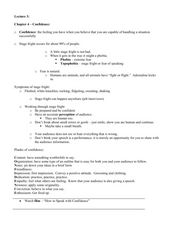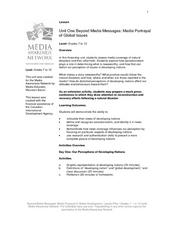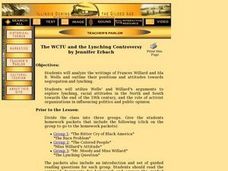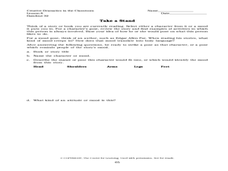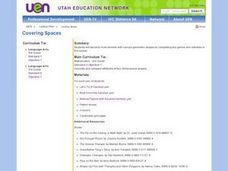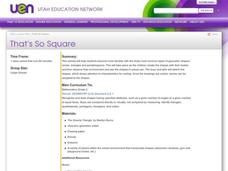Curated OER
Confidence
Students explore communication and confidence issues. For this communication and confidence lesson, students discuss fear, stage fright, phobia's in relation to the planks of confidence. Students view a related film. Students explore...
Curated OER
Beyond Media Messages: Media Portrayal of Global Issues
Take a close look at news reporting techniques and global issues. Begin by creating a graphic representation of developing nations and defining the term. After class discussion, the second day's activities pick up by deconstructing news...
Media Smarts
Bias in News Sources
As young consumers of media, it is important for high schoolers to explore concepts of bias and prejudice, and how they may be present in media. After discussing ideological messages that media can contain, individuals complete a warm-up...
Curated OER
Colonial Broadsides and the American Revolution
Middle schoolers access the Library of Congress's collection of Broadsides (printed material with news, entertainment, advertisements, etc.) and explore their impact on events leading up to the Revolutionary War. They create a timeline...
Curated OER
Plan a Meal Fun
Discuss helping with the family grocery shopping. View a teacher drawn map of a grocery store and discuss where the breads, meats, and dairy products are located. Practice categorizing foods as breads and cereals, fruits, vegetables,...
Curated OER
Taking Action
Learners use the net they make to dip macroinvertebrates at or below the surface. The flat side of the net allows pressure on the substrate so that organisms do not escape under the net. Two students hold onto the handles and submerge...
Curated OER
The WCTU and the Lynching Controversy
Eleventh graders analyze the writings of Frances Hard and Ida B. Wells and outline their positions and attitudes towards segregation and lynching. They utilize Wells' and Hard's arguments to explore lynching, racial attitudes in the...
Curated OER
We are all Responsible
Students desribe the interdependence between humans and nature and positive behavior with regards to natural resources. They demonstrate respectful attitudes and behaviors with regards to the environment. Students gain knowledge of...
Curated OER
Posture and Pantomime: Total Body Movement
Students analyze posture and pantomime in an analysis of total body movement. In this body movement lesson, students read a chart of movements and the mood or attitude they convey. Students complete several space and observation...
Curated OER
Spirit of Islam: Wrapping It Up
Students develop an action plan for overcoming stereotypes of the Muslim faith based on research they have conducted in previous lessons.
Curated OER
Negro Leagues Baseball
Students think critically and creatively while researching Negro Leagues baseball vocabulary terms and producing a political cartoon defining those terms. The research for this lesson is done on the internet.
Curated OER
Around the Sun We Go
Sixth graders complete a short survey on the relationship between the Earth and the Sun. In groups, they participate in an experiment in which they test the angle of the Earth and compare it to the sun. To end the lesson, they discuss...
Curated OER
Covering Spaces
Third graders become more familiar with various geometric shapes by completing the games and activities in this instructional activity. They keep track of the number of each shape they use in each of the three ways.
Curated OER
Ancient Chinese Tomb Building
Young scholars compare and contrast the monuments erected for George Washington, the first president of the United States, and Qin Shi Huangdi (r. 221- 210 BCE), the first emperor of China. This lesson also includes a creative project.
Curated OER
That's So Square
Second graders are introduced to circles, triangles and parallelograms. As a class, they create the shape with their bodies and are shown the shapes in their actual size. To end the instructional activity, they sketch each shape and...
Curated OER
Saint John: Harboring the World
Sixth graders write an invitation letter to potential immigrants to St. John, New Brunswick, Canada. Using internet research, 6th graders gather information from a virtual museum exhibit highlighting the positive reasons to move to St....
Curated OER
BEE a Part of Our Community
Pupils reflect how to form a respectful classroom community. In this communities lesson, students construct a "community web" of positive comments and predict what happens to the web when negative comments are made. Pupils discuss how to...
Curated OER
Generating and Recording Data
Students demonstrate their ability to collect, organize, and display data. They examine everyday objects that can be turned into a function machine for the lesson plan. They use colored fish to help them organize their data.
Curated OER
Vocations: Archdiocese of Cincinnati
Students review virtues lived by the saints. They listen as the teacher describes the process by which a person is named a saint. Students generate a list of gifts and talents, and ways a person could use those talents in a positive,...
Curated OER
Likely or Unlikely
Fifth graders are introduced to the concept of probability. Using colored tiles, they pick one out of a bag and determine the probability of pulling out the same color again. To end the instructional activity, they complete the...
Curated OER
Food Pyramid
Second graders are introduced to the food groups on the food pyramid. Individually, they draw pictures of their favorite foods and identify which food group it belongs. To end the lesson, they discuss the importance of eating a variety...
Curated OER
Making Tangram Pieces by Folding Paper
Third graders follow directions to make a set of tangram pieces. After reading a story, they compare and contrast the differences between two-dimensional shapes. To end the lesson, they use the tangram pieces to create their own...
Curated OER
What's Your Function?
Second graders read the rules of how they can balance the scale by placing beans in the square, circle, and the triangle. Next, they balance 12 beans using the scale and then try to balance it with 15 beans, and then 18 beans. They then...


